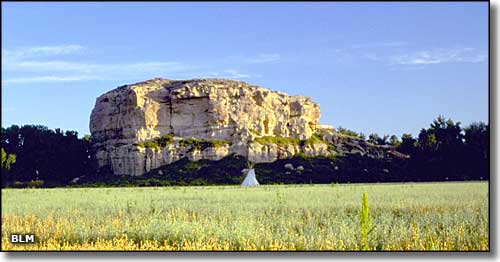 |
Jean Baptiste Charbonneau |
 Historic marker near the grave of Jean Baptiste Charbonneau |
|
Jean Baptiste Charbonneau (February 11, 1805 - May 16, 1866) was the son of Sacajawea (of Lewis & Clark Expedition fame) and Toussaint Charbonneau, a French-Canadian trapper and interpreter. Baptiste, as he was most often called, accompanied his parents as they journeyed with the Lewis & Clark Expedition in 1805-1806. The Lewis & Clark Corps of Discovery wintered in 1804-1805 at Fort Mandan and while there, hired Toussaint Charbonneau as an interpreter to accompany them in their travels. They agreed to bring his then-pregnant wife, Sacajawea, along as she was of the Shoshone tribe, a tribe they knew they'd have to negotiate with near the headwaters of the Missouri River. "Pompy," as he was often referred to, was about 2 months old when the Corps of Discovery left winter camp in North Dakota and headed west for Oregon country. He made nearly the entire jourey either laying in one of the expedition's boats or carried in a sling on his mother's back (as depicted on the Sacajawea gold dollar coin). Pompeys Pillar in Montana is named for him. Clark grew very fond of the little boy on the journey, and when they returned to North Dakota in 1806, he offered to take him to St. Louis and raise him as his own child. The Charbonneau's declined at first, but later that year Clark offered again and the Charbonneau's traveled to St. Louis with Baptiste and stayed long enough to see him enrolled in the St. Louis Academy. Then the Charbonneau's returned to North Dakota and Clark continued to oversee Baptiste's care and schooling. At 18, Baptiste was introduced to Prince Paul Wilhelm von Wurttemberg, a nephew of King Frederick I of Germany. After completing a scientific exploration of Montana country, the prince invited Baptiste to accompany him back to Europe. At that point, young Charbonneau was fluent in 3 languages. In Europe he learned German and Spanish while traveling throughout Europe and North Africa for 6 years. In 1829, he and the prince returned to America and journeyed to Montana once again, this time going to the headwaters of the Missouri and then back down the Yellowstone. When the prince decided to return to Europe, Baptiste decided to stay on the frontier and took up the life of a trapper with the American Fur Company. By the 1840's, the fur trade had just about died out and Baptiste was then making his living as a guide for explorers and foreign visitors. He hung out with folks like Jim Bridger, Andrew and Solomon Sublette, Jim Beckwourth, William Emory, John C. Fremont, James Abert, and Joe Meek. He led many hunting trips for European noblemen, including a well-documented trip with Sir William Drummond Stuart in 1843. In 1846-1847, he and Antoine Leroux guided the Mormon Battalion across the southwestern deserts from New Mexico to San Diego, California. In California he served for a while as alcalde (mayor) of the mission at San Luis Rey, until he was acccused of favoring the local Native Americans more than he should have (according to some legal documents from that time). In 1848 he traveled north to the Sacramento area and caught gold fever. There's no record of him doing well as a gold miner but he was working as a clerk at the Orleans Hotel in Auburn, California in 1861. He lived in the vicinity of Placer County for 18 years before hearing of more gold strikes near Virginia City, Montana. He set off to return to the scenes of his youth but caught pneumonia and died in the Owyhee Valley of eastern Oregon. He's buried next to an early stagecoach stop in the ghost town of Danner, Oregon. |
 Pompey's Pillar |
|
|
 |
| Index - Arizona - Colorado - Idaho - Montana - Nevada - New Mexico - Utah - Wyoming National Forests - National Parks - Scenic Byways - Ski & Snowboard Areas - BLM Sites Wilderness Areas - National Wildlife Refuges - National Trails - Rural Life Advertise With Us - About This Site - Privacy Policy |
| Photo of Jean Baptiste Charbonneau's grave marker courtesy of Wikipedia userid Blazerfan_77 Photo of Pompey's Pillar courtesy of the Bureau of Land Management. Text Copyright © by Sangres.com. All rights reserved. |